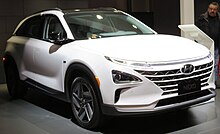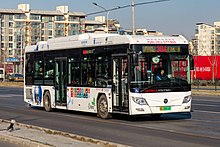
Back مركبة خلايا الوقود Arabic Cerbyd trydan cell danwydd Welsh Brennstoffzellenfahrzeug German Vehículo de celda de combustible Spanish خودرو پیل سوختی Persian Polttokennoauto Finnish Véhicule à pile à combustible French 燃料電池自動車 Japanese 연료전지 자동차 Korean Veculo de pila de combustable LFN
A fuel cell vehicle (FCV) or fuel cell electric vehicle (FCEV) is an electric vehicle that uses a fuel cell, sometimes in combination with a small battery or supercapacitor, to power its onboard electric motor. Fuel cells in vehicles generate electricity generally using oxygen from the air and compressed hydrogen. Most fuel cell vehicles are classified as zero-emissions vehicles. As compared with internal combustion vehicles, hydrogen vehicles centralize pollutants at the site of the hydrogen production, where hydrogen is typically derived from reformed natural gas.[1] Transporting and storing hydrogen may also create pollutants.[2] Fuel cells have been used in various kinds of vehicles including forklifts, especially in indoor applications where their clean emissions are important to air quality, and in space applications. Fuel cells are being developed and tested in trucks, buses, boats, ships, motorcycles and bicycles, among other kinds of vehicles.
The first road vehicle powered by a fuel cell was the Chevrolet Electrovan, introduced by General Motors in 1966.[3] The Toyota FCHV and Honda FCX, which began leasing on December 2, 2002, became the world's first government-certified commercial fuel cell vehicles,[4][5][6] and the Honda FCX Clarity, which began leasing in 2008, was the world's first fuel cell vehicle designed for mass production rather than adapting an existing model.[7] In 2013, Hyundai Motors began production of the Hyundai ix35 FCEV, claimed to be the world's first mass-produced fuel cell electric vehicle,[8][9][10] which was subsequently introduced to the market as a lease-only vehicle.[11][12] In 2014, Toyota began selling the Toyota Mirai, the world's first dedicated fuel cell vehicle.[13][14][15]
As of December 2020[update], 31,225 passenger FCEVs powered with hydrogen had been sold worldwide.[16] As of 2021[update], there were only two models of fuel cell cars publicly available in select markets: the Toyota Mirai (2014–present) and the Hyundai Nexo (2018–present). The Honda Clarity was produced from 2016 to 2021, when it was discontinued.[17] The Honda CR-V e:FCEV became available, for lease only, in very limited quantities in 2024.[18] As of 2020, there was limited hydrogen infrastructure, with fewer than fifty hydrogen fueling stations for automobiles publicly available in the U.S.[19] Critics doubt whether hydrogen will be efficient or cost-effective for automobiles, as compared with other zero-emission technologies, and in 2019, The Motley Fool opined: "What's tough to dispute is that the hydrogen fuel cell dream is all but dead for the passenger vehicle market."[20]
A significant number of the public hydrogen fuel stations in California are not able to dispense hydrogen.[21] In 2024, Mirai owners filed a class action lawsuit in California over the lack of availability of hydrogen available for fuel cell electric cars, alleging, among other things, fraudulent concealment and misrepresentation as well as violations of California’s false advertising law and breaches of implied warranty.[22]
- ^ "Hydrogen Production: Natural Gas Reforming". Office of Energy Efficiency and Renewable Energy. Retrieved July 15, 2022.
- ^ "How Do Hydrogen Fuel Cell Vehicles Work?". Union of Concerned Scientists. Retrieved July 24, 2016.
- ^ "The history of hydrogen fuel cell cars". The Market Herald. December 29, 2021. Archived from the original on January 29, 2023.
- ^ "Toyota to lease fuel-cell cars to state". The Japan Times. November 19, 2002. Archived from the original on March 8, 2023.
- ^ "First Honda FCX Fuel Cell Vehicles Delivered on Same Day in Japan and the U.S." Honda. December 3, 2002. Archived from the original on March 8, 2023.
- ^ "Hydrogen-powered Honda achieves world first". The Japan Times. July 26, 2002. Archived from the original on January 7, 2019.
- ^ "Honda FCX Clarity, world's first series production fuel cell car". Verizon Media. November 18, 2007. Archived from the original on July 29, 2021.
- ^ "Hyundai Motor's fuel-cell car sales miss target". Yonhap News Agency. June 15, 2015. Archived from the original on June 21, 2015.
- ^ "Hyundai ix35 Fuel Cell", accessed November 18, 2018
- ^ "The World’s First Mass-Production of FCEV", accessed November 18, 2018
- ^ "Hyundai ix35 Fuel Cell launching in 2014 with free hydrogen fuel". Drive.com.au. November 22, 2013. Archived from the original on July 6, 2022.
- ^ "The Tucson Fuel Cell FAQ | HyundaiHydrogen.ca". Archived from the original on March 24, 2016. Retrieved March 28, 2016.
- ^ "Toyota's Fuel-Cell Car Mirai Goes on Sale". The Wall Street Journal. December 15, 2014. Archived from the original on May 26, 2018.
- ^ "Toyota to quadruple production of Mirai fuel-cell vehicles by 2017". The Japan Times. January 23, 2015. Archived from the original on July 6, 2015.
- ^ "Toyota Mirai x Hydrogen: the world's first mass produced HFCV". January 20, 2017. Archived from the original on May 16, 2022. Retrieved March 8, 2023.
- ^ International Energy Agency (IEA), Clean Energy Ministerial, and Electric Vehicles Initiative (EVI) (April 29, 2021). "Global EV Outlook 2021: Accelerating ambitions despite the pandemic". International Energy Agency. Retrieved May 17, 2021.
{{cite web}}: CS1 maint: multiple names: authors list (link) Go to the Global EV Data Explorer tool and choose "EV Stock", "Cars" and "World" for global stock, and "Country" for the country stock. - ^ "Honda discontinues hydrogen-fuelled Clarity FCV due to slow sales". June 16, 2021. Retrieved July 29, 2021.
- ^ Voelcker, John. "Hydrogen Fuel-Cell Vehicles: Everything You Need to Know", Car and Driver, April 29, 2024
- ^ Cite error: The named reference
AFDCwas invoked but never defined (see the help page). - ^ Hoium, Travis (July 25, 2022). "Hydrogen Cars Appear Dead as EVs Take the Reins". The Motley Fool. Retrieved September 18, 2021.
- ^ "Station Status", Hydrogen Fuel Cell Partnership. Retrieved October 17, 2024; and "Southern California Retail Hydrogen Station Network Status in California", Hydrogen Fuel Cell Partnership, July 19, 2024
- ^ Martin, Polly. "Toyota sued over lack of hydrogen availability for fuel cell cars in California", Hydrogen Insight, July 15, 2024


